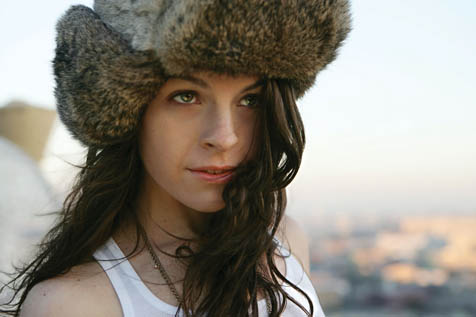Songstress Jesca Hoop on Her Unconventional Rise
Into the Wild

Phoning in while tearing through downtown Los Angeles in the rain, scouting out potential recording studios in between interviews, Jesca Hoop sounds like your atypical city girl-almost. In conversation, the singer/songwriter comes across as decidedly nymph-like, speaking with an accent that sounds much like Elvish despite being raised by a strict Mormon family in Northern California. And from there, her backstory only gets weirder. Brought up in a delightfully musical, but very religious, family, Hoop broke away from the church when her parents split, turning to nature (namely that of Wyoming, California, and Arizona) and taking up work as a caregiver and counselor for mixed-up kids. Though she continued to write songs throughout her adventures, it wasn’t until a particular pair came along that Hoop felt compelled to pursue music as a career.
While playing nanny for Tom and Kathleen Waits’s three children, Hoop realized her musical might and began performing in small NorCal venues. Soon after, Hoop’s demo made it into the hands of KCRW program director Nic Harcourt, and the rest, as they say, is history. The single “Seed of Wonder” went on to break station request records, and Hoop moved to L.A. A full-length album, Kismet, soon followed, as well as an opportunity to play show-opener for indie rock heavyweights the Polyphonic Spree. On Friday, February 1, Hoop will bring her songs-an eclectic mix of pop and folk that calls to mind Kate Bush and Bjrk simultaneously-to SOhO for a show that is sure to win Hoop plenty more new fans.
Your musical story is definitely an interesting one. Where were you when Nic starting playing your stuff on KCRW? How long did it take you to decide to make the move to L.A.? I was living in Sonoma County, out of my van, when they started playing my music on the radio. I was saving up to move to L.A. The person I wanted to make a record with, Damian Anthony, was living down in L.A., so I was kind of working toward moving here. I was living out of my car to save up the money. L.A. is kind of expensive-you need a deed fund. When they started playing my music it kind of accelerated the whole process :
And how did you and Tom Waits originally meet? Through an acquaintance, but also being at the right place at the right time. My process of working [for the Waits] was a long one. At one point, I kind of forgot about doing anything else because it was such a comfortable atmosphere.
I know you grew up in a very musical family. How did your home life compare to the Waits’s? It was very different. [At home] singing together was like a family pastime that kind of stemmed from our religion. In the Waits family, they’re all very creative in their own right, but they don’t necessarily geek out the way we did. [It was] like The Sound of Music. I could have easily been seen as growing up in a musical, and I think that Tom and Kathleen are just a little more cool than that.
Kismet is absolutely beautiful, but it also employs a good deal of abstraction. How would you describe your music and what you write about? Well, I heard it the other day described best by David Byrne. He was the first person to put it closest to accurate, which is “unusual, contemporary pop songs.” It’s a practical description, but they are unusual, they are contemporary, and they are pop songs-they’re just not pop as you would expect them. They all have a hook, most of them have choruses that are catchy, but they’re not in the ways that you would necessarily be used to.
And there’s a great deal of amazing instrumentation on the album. How much of that was you and how does that translate when you play live? The production was a combination of three heads at work, and I would say that it’s a good balance of the three. Damian Anthony was the person to kind of break me in and help me move toward what is more natural for me while still incorporating a more modern element : On the road, the written element is at play. It’s a little bit more broken down, but Damian also helps me : He plays the MPC, which is a drum machine basically, so he can incorporate different elements from the record. It’s reminiscent of the record, but not a carbon copy by all means.
You spent a lot of time surrounded by nature when you were younger. Now that the album has brought you to L.A., how or where do you look for inspiration? I guess everywhere. I’ve written so much of my most poppy material in a tent, it’s hard to say. I look at what’s happening in the world around me and in the layers between; conversations, songs, other people’s lyrics, movies, certain moments. I’ve realized it’s all the same, whether this be a cement jungle or a jungle in the Congo, it’s all one big wild landscape.
4•1•1 Jesca Hoop plays SOhO on Friday, February 1, with United by Sound. Call 962-7776 or visit sohosb.com for details.



